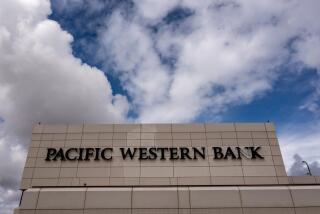In a First, Pacific Mutual Life, MONY Will Combine Ailing Group Units
- Share via
Two of the nation’s largest life insurance companies--Pacific Mutual Life of Newport Beach and Mutual Life of New York--said Thursday that they will put some of their ailing group health and life operations into a new joint venture.
The venture, first of its kind in the insurance industry, is aimed at stemming the flow of red ink from their group insurance businesses--the umbrella policies that cover large groups, such as company employees and their dependents.
Pacific Mutual expects to report a 1987 loss of $2 million to $5 million on its group insurance operations, while Mutual of New York expects a loss of $5 million to $7 million on its group business, officials at the companies said.
Both insurers said they are confident that the joint venture will significantly reduce costs and enable their group health and life divisions to post profits for 1988.
The joint venture, to be operated by Pacific Mutual at its Fountain Valley facility, would handle group health and life administration and claims processing for both firms. The companies would continue to compete in other areas, with separate insurance products and sales and marketing departments.
Group insurance revenue accounted for about 25% of Pacific Mutual’s $2.2 billion total revenue and about 5% of Mutual of New York’s $4.6 billion in total revenue in 1986, the last year for which full financial results are available.
Pacific Mutual is the nation’s 24th-largest life insurance firm, with $5.5 billion in assets. Mutual of New York is the nation’s 14th-largest, with $11.2 billion in assets.
While the joint venture agreement is still tentative, executives at both companies said, it is so comprehensive that little work needs to be done before they sign a contract sometime in the next two months.
Neither company would reveal the percentage interest that each holds in the joint venture.
Pacific Mutual does not expect to lay off any employees. The company said it expects its cost savings to result from increased technological efficiency.
Mutual of New York said it plans to eliminate 220 positions beginning in May or June. About 40 of those employees are being transferred to new jobs within the company, a spokesman said.
Industry analysts hailed the agreement as an alternative that could allow insurance carriers to stay in the group insurance business, a sector expected to post more than $1 billion in losses in 1987--its worst performance ever.
“I think it’s a tremendous experiment,” said David Seifer, an analyst with First Boston, a securities firm in New York. “If it can work, there’s no reason only two have to do it. Maybe 10 or 20 other insurance companies can join together with a centralized computer.”
Pacific Mutual and Mutual of New York executives said there is room for other group insurance carriers to become partners in the joint venture, to be called Employee Benefits America Administration Co. Pacific Mutual already is talking with another large insurer about signing up, the company said.
“Our joint arrangement with Pacific Mutual is a creative solution to a problem impacting many companies today--generating favorable financial performance in an extremely dynamic and competitive marketplace,” said James A. Attwood, chairman and president of Mutual of New York.
Harry G. Bubb, Pacific Mutual’s chairman and chief executive, said the venture is “the beginning of a new commitment to providing more competitive services in the group insurance industry.”
Neither industry analysts nor company executives could cite any other insurance companies that have merged part of their operations into a new company to cut administrative costs while remaining competitive.
Under the agreement, EBAA would receive fees from both Pacific Mutual and MONY for collecting an estimated $800 million a year in premiums--$550 million for Pacific Mutual and $250 million for MONY.
The new arrangement also should not present any antitrust problems, Kimmerle said, because the combined operations represent only 2% of nationwide group insurance revenues.
More to Read
Inside the business of entertainment
The Wide Shot brings you news, analysis and insights on everything from streaming wars to production — and what it all means for the future.
You may occasionally receive promotional content from the Los Angeles Times.









